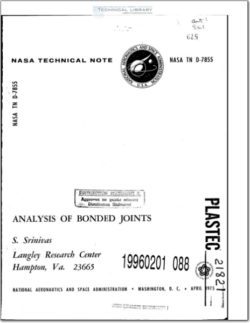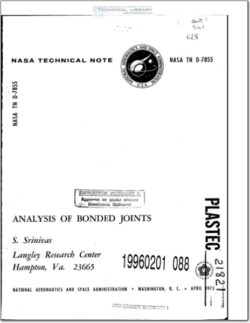NASA-TN-D-7855

- Version
- 565 Downloads
- 1.39 MB File Size
- 1 File Count
- December 13, 2015 Create Date
- December 13, 2015 Last Updated
Analysis of Bonded Joints

A refined elastic analysis of bonded joints which accounts for transverse shear
deformation and transverse normal stress was developed to obtain the stresses and dis—
placements in the adherends and in the bond. The displacements were expanded in terms
of polynomials in the thicknesswise coordinate; the coefficients of these polynomials were
functions of the axial coordinate. The stress distribution was obtained in terms of these
coefficients by using strain-displacement and stress—strain relations. The governing dif—
ferential equations were obtained by integrating the equations of equilibrium. These dif—
ferential equations were solved, and the boundary conditions (interface or support) were
satisfied to complete the analysis.
Single—lap, flush, and double—lap joints were analyzed. The effects of adhesive
properties, plate thicknesses, material properties, and plate taper on maximum peel and
shear stresses in the bond were studied. Also, the results obtained by using the thin-
beam analysis available in the literature were compared with the results obtained by using
the refined analysis. In general, thin—beam analysis yielded reasonably accurate results,
but in certain cases the errors were high. Numerical investigations showed that the maxi—
mum peel and shear stresses in the bond can be reduced by (1) using a c0mbination of
flexible and stiff bonds, (2) using stiffer lap plates, and (3) tapering the plates. Of the
three joints considered, for a given total adhesive thickness and joint volume, the double—
lap joint had the smallest maximum peel and shear stresses in the bond, whereas the flush
joint had the highest.
Bonded joints in primary structures are becoming increasingly common. In these
joints, the adhesive which transfers the load from one member to another is subjected to
a shear stress and a normal stress in the thickness direction (called peel stress). The
joint, when subjected to static or fatigue loads, can fail from excessive shear or peel
stresses in the bond. Thus, for a proper design of bonded joints, reasonably accurate
estimates of the maximum peel and shear stresses in the bond are needed. Several papers
in the literature deal with the stress analysis of bonded joints. De Bruyne (ref. 1) ana-
lyzed single-lap joints but ignored the bending effects. Goland and Reissner (ref. 2) ana-
lyzed single—lap joints, taking into account large deflections.
| File | Action |
|---|---|
| NASA-TN-D-7855 Analysis of Bonded Joints.pdf | Download |
Comment On This Post